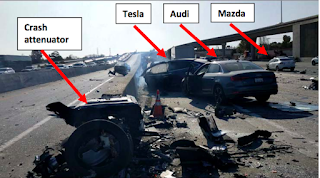- Tesla's Autopilot system allows for automated driving operations that exceed the posted speed limit on highways.
- There was no warning to the driver to take over driving in the seconds prior to the crash. It probably would not have made a difference even if the driver had been alerted in the two or three seconds before the crash because human beings do not jump to attention that quickly.
- The Tesla Autopilot system did not "see" the barrier that the car crashed into.
- The Tesla driver was not paying attention because people don't whenever they have an excuse not to. In fact, many people allow themselves to be distracted even whey they drive conventional vehicles that have little or no automated technology.
- The Tesla driver was not the only person injured, although he was the only fatality. One other driver was injured as well. However, the possibility in a crash involving a vehicle operating at over 70 mph that speeds right into a concrete barrier is that many people could be seriously injured or killed - people who have not assumed the risk of driving or riding in a vehicle with a less-than-omniscient, partially automated driving system.
- All of the above.
 |
| Photo from NTSB Preliminary Report |
Wait, it gets better - or, actually, worse. "At 3 seconds prior to the crash and up to the time of impact with the crash attenuator, the Tesla’s speed increased from 62 to 70.8 mph, with no precrash braking or evasive steering movement detected."
Yup, nada. AND the "lithium-ion battery was breached," which means - and I don't have to consult my materials scientist phd student on this (a battery specialist, by the way) - fire is coming. Yes, it started and blazed after the crash, though bystanders risked their own lives to extricate the driver and rescue him before the flames, while he still lived.
And the battery reignited five days later. I mention that for no other reason than to harp on the oy-vey nature of this preliminary report.

No comments:
Post a Comment